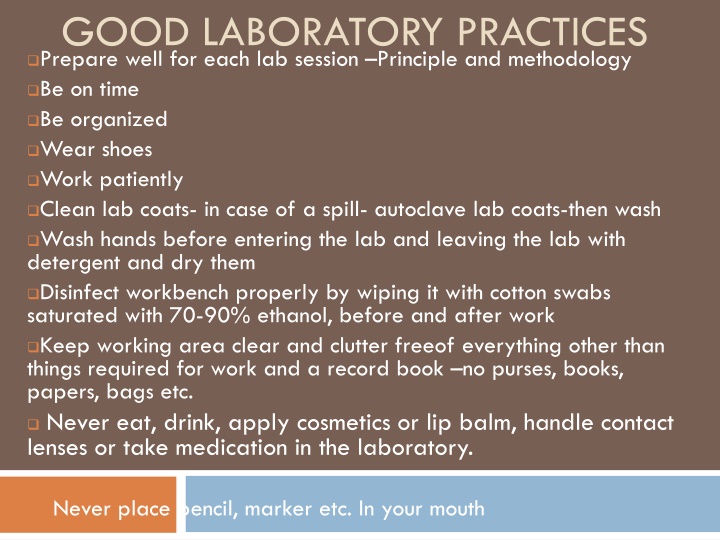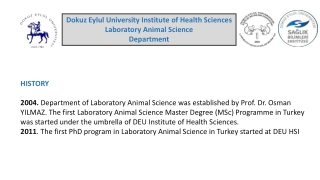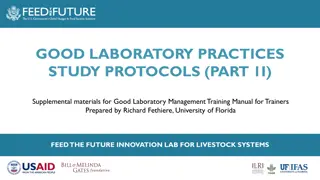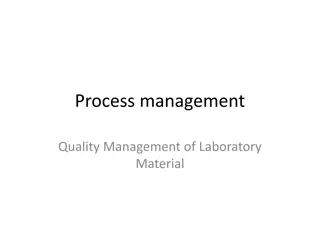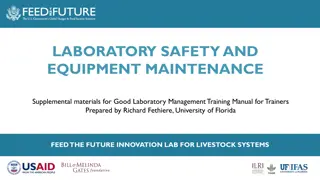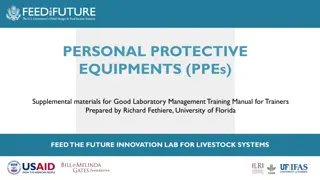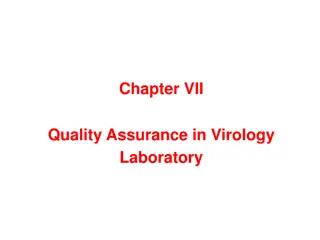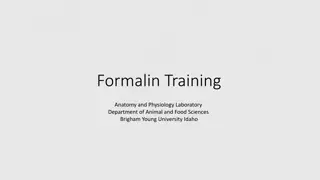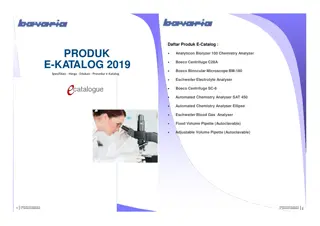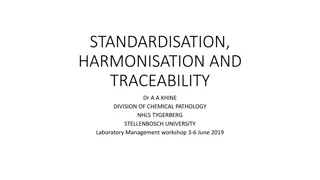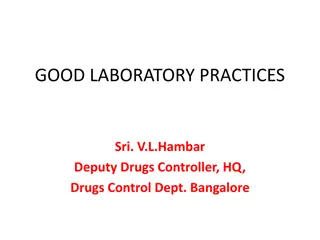GOOD LABORATORY PRACTICES
Proper preparation and conduct are crucial in laboratory settings. Prioritize organization, hygiene, and safety measures. Follow guidelines for handling equipment, materials, and waste. Always prioritize cleanliness, communication, and caution to ensure a productive and secure laboratory environment.
Download Presentation

Please find below an Image/Link to download the presentation.
The content on the website is provided AS IS for your information and personal use only. It may not be sold, licensed, or shared on other websites without obtaining consent from the author.If you encounter any issues during the download, it is possible that the publisher has removed the file from their server.
You are allowed to download the files provided on this website for personal or commercial use, subject to the condition that they are used lawfully. All files are the property of their respective owners.
The content on the website is provided AS IS for your information and personal use only. It may not be sold, licensed, or shared on other websites without obtaining consent from the author.
E N D
Presentation Transcript
GOOD LABORATORY PRACTICES Prepare well for each lab session Principle and methodology Be on time Be organized Wear shoes Work patiently Clean lab coats- in case of a spill- autoclave lab coats-then wash Wash hands before entering the lab and leaving the lab with detergent and dry them Disinfect workbench properly by wiping it with cotton swabs saturated with 70-90% ethanol, before and after work Keep working area clear and clutter freeof everything other than things required for work and a record book no purses, books, papers, bags etc. Never eat, drink, apply cosmetics or lip balm, handle contact lenses or take medication in the laboratory. Never place pencil, marker etc. In your mouth
Live culture spill: cover the entire spill area with dis- infectent (lysol 1:500, phenol 1:100, clorox bleach 10%) If there is personal injury-cut or burn inform instructor and go for first aid Tie long hair, avoid unnecessary movement and talking. Be very very careful of burners and turn them off when not in use All microbial cultures should be handled as being potentially pathogenic Waste papers and contaminated glassware should be kept in provided space No mouth pipetting ever in the lab Disinfect incubators, fridges etc regularly
Do not open anything with mouth or teeth, no testing any lag material orally Open all containers away from your face, nose, eyes If at all you have to smell something, smell some vapours by fanning with your hands. always switch off microscopes in between experiments when you are not using it. Never look directly into a tube and never point an open tube towards your own or neighbour s face No eatables in lab fridges Shut down everything before leaving lab Use tray to transport any lab material Use gloves whenever instructed Use procedures that generate minimum aerosoles Never walk barefoot in lab
Proper maintenance and cleaning of autoclaves Ensure aseptic conditions in the lab Keep culture tubes in upright position Label all plates, tubes, cultures properly Return everything to its original position after use Always clean microscope-stage, eyepiece, objective lenses before and after use Always perform exercise in sequence Keep doors, windows, fans etc off while performing inoculations Record your data in ink and draw protocols, sketches and diagrams in pencil Proper upkeep of lab record book-very very Imp.
Glassware cleaning: New glassware: TT, flasks, PD, pipetts, glass slides, coverslips etc: dip in teepol or liq detergent solution, heat to boil-rinse in clean water Used glassware: autoclave, discard the waste in assigned bin --- dip in detergent solution wash---rinse with distilled water Used slides and coverslips : dip in teepol or liq detergent solution, heat to boil-rinse in clean water In case of Accident: Report to instructor Burn: apply ice, keep dipping in ice cold water Cut/abrasion : clean with antiseptic, bandage Chemical Spill: keep wash the affected area in running water Large spill: shower Acid burn : wash with detergent extensively (neutralizing effect)
Fire Gas leak: open doors, windows, check all gas burners and pipes Do not switch on any electrical switch Minor fire: smoother with towel or book Larger fire: use fire extinguishers, if unable to control: raise alarm: turn off all gas burners, unplug electrical equipment and evacuate the lab: keep on raising alrm Disposal of broken glass ware: Dont pick it up with bare hand: sweep and pick up using dust pan Place in assigned container
A biosafety cabinet (BSC) also called a biological safety cabinet or microbiological safety cabinet is an enclosed, ventilated laboratory workspace for safely working with materials contaminated with (or potentially contaminated with) pathogens requiring a defined biosafety level
Biohazard An agent of biological origin that can produce deleterious effects on humans i.e. MOs, toxins and allergens Biosafety Application of knowledge, techniques, equipments to prevent personal, lab, environmental exposure to potentially infectious agents or biohazards Biosafety defines containment conditions in which an infectious agent can be safely manipulated Biohazard waste: Solid or liq. Waste potentially contaminated with biological agents that can cause inf. in humans, plants or animals: Eg:1. Zoonotic vectors used in research 2. cultures used in research (human, animal or plant pathology related) 3. GMO 4. Hospital waste : syringes, any disposable accessories used in invasive procedure, organs, tissues, fetus, etc.
Chemical hazard Radiation hazard
laboratory workers should protect their street clothing from contamination by wearing appropriate garments (eg, gloves and shoe covers or lab shoes) when working in Biosafety Level-2 (BSL-2) laboratories. In BSL-3 laboratories the use of street clothing and street shoes is discouraged; a change of clothes and shoe covers or shoes dedicated for use in the lab is preferred. BSL-4 requires changing from street clothes/shoes to approved laboratory garments and footwear. When utilizing sharps in the laboratory, follow " Bloodborne Pathogens standard requirements. Needles/syringes/other sharps should be restricted in laboratories where infectious agents are handled. If you must utilize sharps, consider using safety sharp devices or plastic rather than glassware. Never recap a used needle. Dispose of syringe-needle assemblies in properly labeled, puncture resistant, autoclavable sharps containers. Handle infectious materials as determined by a risk assessment. Airborne transmissible infectious agents should be handled in a certified Biosafety Cabinet (BSC) appropriate to the biosafety level (BSL) and risks for that specific agent. Ensure engineering controls (e.g., BSC's, eyewash units, sinks, and safety showers) are functional and properly maintained and inspected.
Store all biohazardous materials securely in clearly labeled, sealed containers. Storage units, incubators, freezers or refrigerators should be labeled with the Universal Biohazard sign when they house infectious material. Doors of all laboratories handling infectious agents and materials must be posted with the Universal Biohazard symbol, a list of the infectious agent(s) in use, entry requirements (e.g., PPE) and emergency contact information. . Avoid the use of aerosol-generating procedures Tightly cap tubes prior to centrifuging or vortexing; Allow aerosols to settle prior to opening tubes, equipment; Open tubes or equipment inside a containment device whenever feasible; Shield instruments or activities that can emit splash or splatter. Use disinfectant traps and in-line filters on vacuum lines to protect vacuum lines from potential contamination.
Proper maintenance and cleaning of autoclaves Ensure aseptic conditions in the lab Keep culture tubes in upright position Label all plates, tubes, cultures properly Return everything to its original position after use Always clean microscope-stage, eyepiece, objective lenses before and after use Always perform exercise in sequence Keep doors, windows, fans etc off while performing inoculations Record your data in ink and draw protocols, sketchesand diagrams in pencil Proper upkeep of lab record book-very very Imp.
Follow the laboratory biosafety plan for the infectious materials you are working with and use the most suitable decontamination methods for decontaminating the infectious agents you use. Know the laboratory plan for managing an accidental spill of pathogenic materials. Always keep an appropriate spill kit available in the lab. Clean laboratory work surfaces with an approved disinfectant after working with infectious materials. The containment laboratory must not be cluttered in order to permit proper floor and work area disinfection. Never allow contaminated, infectious waste materials to leave the laboratory or to be put in the sanitary sewer without being decontaminated or sterilized. When autoclaving use adequate temperature (121 C), pressure (15 psi), and time, based on the size of the load. Also use a sterile indicator strip to verify sterilization. Arrange all materials being sterilized, so as not to restrict steam penetration. When shipping or moving infectious materials to another laboratory, always use U.S. Postal or Department of Transportation (DOT) approved, leak-proof sealed and properly packed containers (primary and secondary containers). Avoid contaminating the outside of the container and be sure the lid is on tight. Decontaminate the outside of the container before transporting. Ship infectious materials in accordance with Federal and local requirements. Report all accidents, occurrences and unexplained illnesses to your work supervisor and the Occupational Health Physician. Understand the pathogenesis of the infectious agents you work with. Think safety at all times during laboratory operations. Remember, if you do not understand the proper handling and safety procedures properly, do not work with the infectious agents or materials
